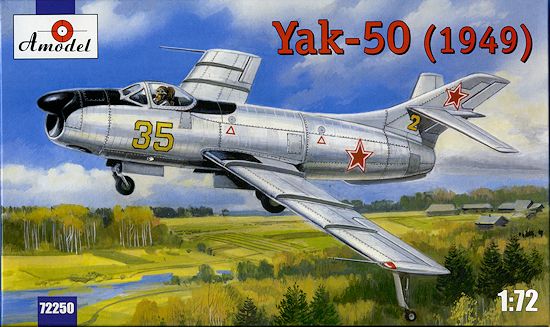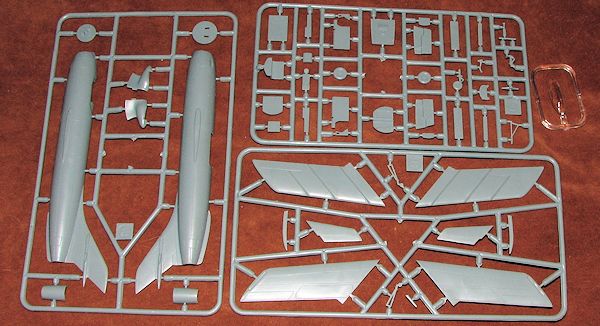
Amodel 1/72 Yak-50
| KIT #: | 72250 |
| PRICE: | $34.95 SRP |
| DECALS: | Two options |
| REVIEWER: | Scott Van Aken |
| NOTES: | Short run kit |

| HISTORY |
Yakovlev Yak-50 was an early experimental turbojet interceptor aircraft designed in 1948 by the Yakovlev OKB in USSR. The aircraft was essentially a stretched version of the Yakovlev Yak-30 (1948), with a more powerful engine and greater sweep to the wings. The Yak-50 is perhaps most significant as the first Yakovlev aircraft equipped with the velosipednoye (bicycle) landing gear, a trademark of later Yakovlev designs. The Yak-50 designation was later reused for a propeller-driven aerobatic and trainer aircraft.
On February 21, 1949 a Sovmin order requested the Yakovlev OKB to design a lightweight, radar-equipped, all-weather and night interceptor capable of Mach 0.97 at 4,000 m (13,000 ft). The aircraft was to utilize the Klimov VK-1 engine which first appeared on Mikoyan-Gurevich MiG-15 and MiG-17 fighters. This engine was itself a Soviet copy of the British Rolls-Royce Nene centrifugal turbojet initially known as the RD-45. The leading fighter OKBs each created a prototype to meet the requirement, which included the Lavochkin La-200, Mig I-320, Suchoi Su-15 (unrelated to the later aircraft with the same designation) and the Yak-50 (again, unrelated to the later aircraft). A major difference was that while Yakolev used one engine, the other design bureaus used two.
The aircraft first flew on 15 July 1949, with test pilot Anokhin achieving supersonic speed (Mach 1.03 at 10,000 m (33,000 ft)) in a shallow dive during one of the test flights.
Ultimately, none of the newly developed aircraft was selected, and an upgraded MiG-17 was eventually employed. Yakolev later used the velosipednoye landing gear in the Yak-140 fighter and the Yak-120, and later in the Yak-25 and Yak-28 where it proved highly successful.
The Yak-50 never received an ASCC name or USAF reporting number.
| THE KIT |
 This is another interesting Soviet prototype aircraft from the folks at Amodel. As you know, Amodel kits are nicely molded, but are short run kits so have some differences from mainstream kits like those from Revell, Tamiya and so on. The biggest is the lack of positive locators for many of the parts, larger than normal molding seams and often the reliance on resin and photo etch for some parts.
This is another interesting Soviet prototype aircraft from the folks at Amodel. As you know, Amodel kits are nicely molded, but are short run kits so have some differences from mainstream kits like those from Revell, Tamiya and so on. The biggest is the lack of positive locators for many of the parts, larger than normal molding seams and often the reliance on resin and photo etch for some parts. Instructions are nicely done with crisp and clear instruction drawings. Painting information using Humbrol and generic color references is provided. Both markings options are in overall unpainted metal, varying only by Bort numbers and tail numbers. The decal sheet is nicely printed and provides the black area behind the cockpit. The area in front of it and the radome will need to be masked and painted by the builder.
Instructions are nicely done with crisp and clear instruction drawings. Painting information using Humbrol and generic color references is provided. Both markings options are in overall unpainted metal, varying only by Bort numbers and tail numbers. The decal sheet is nicely printed and provides the black area behind the cockpit. The area in front of it and the radome will need to be masked and painted by the builder.
| CONCLUSIONS |
If you are looking for something a bit different or have a fondness for prototype aircraft, then this is one you really should look into getting.
| REFERENCES |
http://en.wikipedia.org/wiki/Yakovlev_Yak-50_%281949%29
March 2013
Thanks to me for picking up this one.
If you would like your product reviewed fairly and fairly quickly, please contact the editor or see other details in the